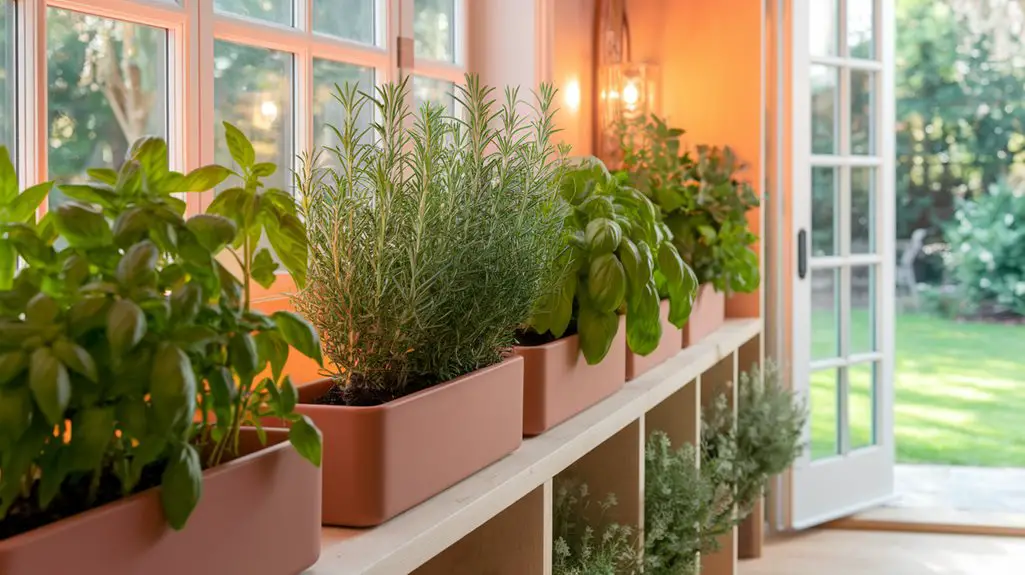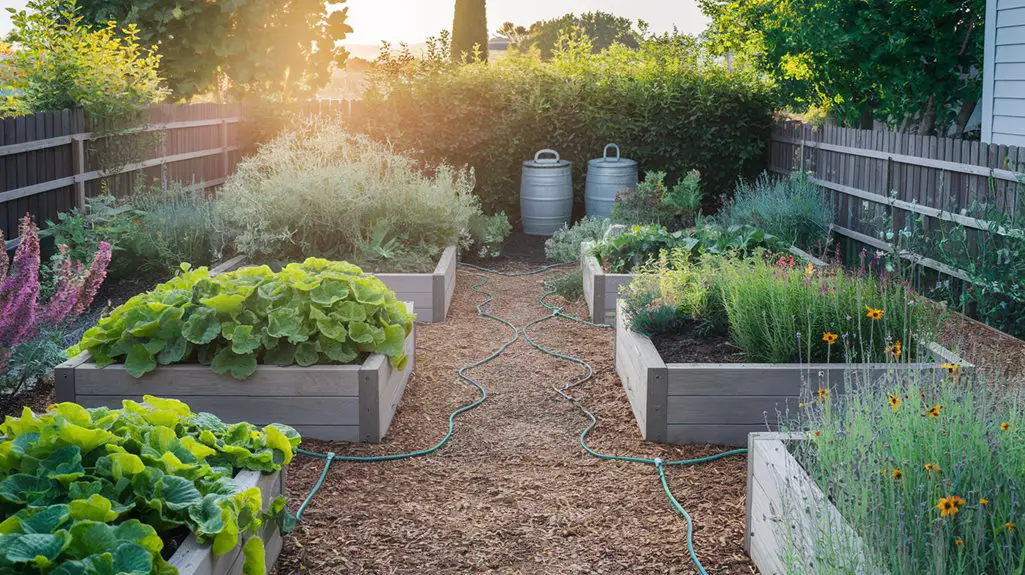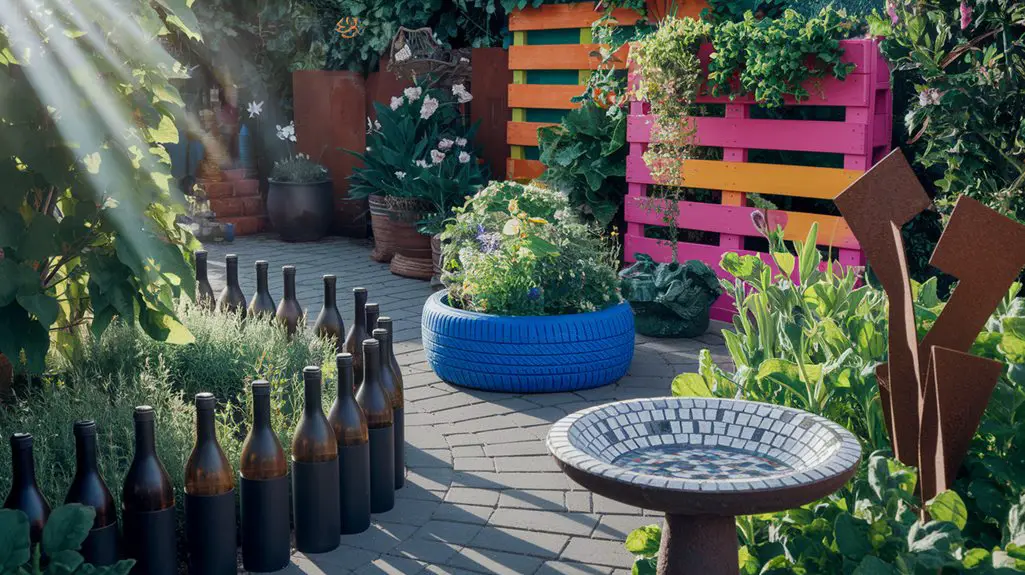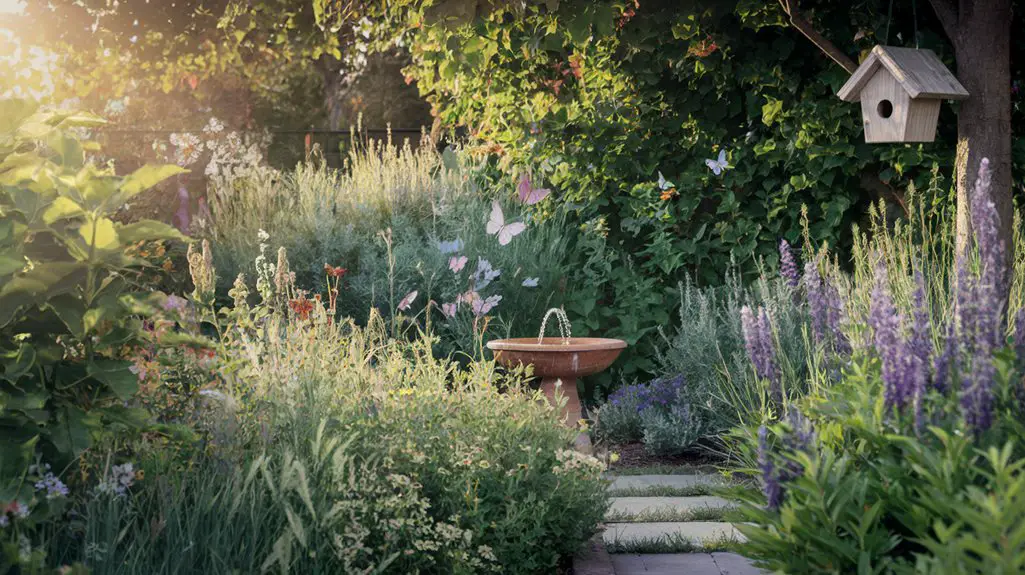Over 65% of home gardeners cite easy access to fresh herbs as their primary motivation for creating an indoor growing space. You'll find that connecting your kitchen and backyard with strategically placed herb gardens maximizes both convenience and plant health. Whether you're a culinary enthusiast or a practical cook, incorporating these ten design concepts can transform how you interact with your herbs and revolutionize your cooking routine. The solutions ahead address common challenges of space, light, and seasonal shifts.
Window Box Herb Gardens: Blending Indoor Convenience With Backyard Views
While traditional herb gardens thrive in outdoor settings, window box herb gardens offer an innovative solution for urban dwellers and those with limited outdoor space.
These installations transform window sills into productive growing zones that connect interior spaces with exterior views.
Select window boxes with proper drainage systems and appropriate dimensions for your selected herbs. South-facing windows provide ideal light exposure (6+ hours daily), though supplemental grow lights can compensate for insufficient natural illumination.
Choose shallow-rooted herbs like thyme, chives, and mint for standard boxes, while deeper containers accommodate basil and rosemary with their more extensive root systems.
Install mounting brackets rated for your box's fully-watered weight to maintain structural integrity.
This setup maximizes limited space while maintaining a visual connection to your backyard environment. Additionally, incorporating herb garden ideas can enhance both aesthetics and functionality in your indoor growing space.
Vertical Herb Wall Systems With Easy Patio Access

When space constraints limit traditional gardening options, vertical herb wall systems provide an elegantly efficient solution that maximizes growing capacity while minimizing footprint. These systems function best when positioned adjacent to patio doorways, facilitating seamless harvest-to-table changes. Incorporating fragrant herb garden ideas can enhance the sensory experience of your indoor herb garden.
| System Type | Irrigation Method | Ideal Herbs |
|---|---|---|
| Pocket Wall | Drip System | Thyme, Oregano, Sage |
| PVC Pipe Grid | Recirculating Pump | Basil, Mint, Cilantro |
| Pallet Conversion | Manual Watering | Rosemary, Chives, Parsley |
| Modular Panels | Self-Watering Reservoir | Marjoram, Dill, Tarragon |
You'll need to install appropriate mounting hardware capable of supporting saturated soil weight. Select UV-resistant materials for systems exposed to direct sunlight through patio doors. Consider incorporating automated irrigation timers to maintain consistent moisture levels, especially during summer months when transpiration rates increase.
Wheeled Herb Carts for Indoor-Outdoor Flexibility

Designed for gardeners who value adaptability, wheeled herb carts provide the perfect solution for maintaining an herb collection that can shift seamlessly between indoor and outdoor environments.
These mobile cultivation platforms typically feature multiple tiers constructed from weather-resistant materials like cedar, galvanized steel, or UV-stabilized polymers.
Select carts with locking casters that guarantee stability during stationary periods while facilitating smooth shifts across thresholds.
Ideal designs incorporate modular planting trays with integrated drainage systems to prevent root saturation.
For maximum versatility, choose models with adjustable shelving to accommodate herbs of varying heights and growth habits.
You'll benefit from positioning sun-loving varieties like rosemary and thyme on upper tiers, while shade-tolerant herbs such as mint and parsley can thrive on lower shelves.
This strategic arrangement enhances photosynthetic efficiency while maintaining convenient harvesting access. Additionally, raised bed herb gardens can be a great complement to your wheeled carts, providing a stable growing environment for herbs that flourish outdoors.
Hydroponic Herb Gardens Near Garden-Facing Doors

Positioning hydroponic herb gardens adjacent to garden-facing doors creates a perfect microclimate where indoor convenience meets natural light availability. These locations leverage shifting light patterns while maintaining climate control for peak growth.
Install vertical hydroponic systems using NFT (Nutrient Film Technique) or DWC (Deep Water Culture) methods on walls flanking doorways. These setups maximize photosynthetic efficiency through strategic placement in partial sunlight zones, creating a seamless cultivation bridge between indoor and outdoor environments.
Incorporate automatic dosing systems that maintain precise EC (electrical conductivity) and pH levels between 5.5-6.5 for most culinary herbs. Additionally, consider small herb garden ideas that can optimize space and enhance your indoor gardening experience.
Select door-adjacent placement to facilitate easy harvest while minimizing temperature fluctuations that could stress plants when moving cuttings between indoor systems and outdoor garden beds.
Hanging Herb Baskets for Kitchen-to-Yard Transitions

Hanging herb baskets represent an elegant solution for spaces that connect kitchen environments with outdoor areas. You'll maximize vertical growing space while creating a harmonious change between indoor cooking areas and outdoor landscapes. Additionally, raised garden beds can complement your herb baskets by providing a dedicated space for larger herb varieties and other vegetables.
| Basket Type | Best Herbs | Positioning |
|---|---|---|
| Macramé | Trailing thyme, oregano | Adjacent to windows |
| Wire mesh | Mint, lemon balm | Door overhangs |
| Terracotta | Rosemary, sage | Pergola changes |
Install adjustable pulley systems to lower baskets for harvesting and maintenance. Integrate drip irrigation with moisture-sensing technology to maintain ideal soil conditions. Select trailing varieties that cascade naturally, creating visual continuity between environments. For kitchen-to-yard changes, position baskets sequentially by mature height to establish a gradient effect that draws the eye outward.
Stackable Herb Planters for Limited Window Space
Space constraints near windows need not limit your indoor herb cultivation potential. Stackable planters maximize vertical real estate while ensuring adequate light exposure for photosynthesis.
These modular systems typically feature individual growing compartments arranged in vertical tiers, creating a gradient exposure pattern that accommodates herbs with varying light requirements.
Select planters with integrated drainage systems to prevent root rot—crucial for Mediterranean herbs like rosemary and thyme that prefer drier conditions.
Opt for configurations with rotating capabilities that allow for uniform light distribution and prevent phototropic leaning.
For ideal efficiency, position moisture-loving herbs (basil, cilantro) on lower levels where water naturally accumulates, while drought-tolerant varieties (sage, oregano) perform better in upper tiers.
The stepped arrangement also facilitates microclimate creation, with temperature variations of 2-3°F between tiers. Additionally, incorporating edible landscaping ideas into your indoor garden can enhance both aesthetics and functionality.
Sunroom Herb Stations With Direct Garden Connection
Sunrooms provide an ideal shift growing environment for herbs by maintaining average daytime temperatures between 70-80°F while offering 6-8 hours of diffuse natural light through their transparent enclosures.
Position herb stations along the perimeter walls where they'll receive optimal light exposure while maintaining proximity to exterior doors for seamless outdoor garden access.
Establish a functional connection between indoor and outdoor growing spaces with:
- Wheeled planter carts (18"-24" height) that can shift between environments during seasonal changes
- Dedicated propagation stations where seedlings germinate before transplanting outdoors
- Irrigation systems with dual-zone capabilities that extend from sunroom to exterior garden beds
This shifting growing approach enhances cultivation continuity throughout the year, allowing you to maintain harvest cycles regardless of external climate conditions while facilitating genetic diversity through cross-pollination between indoor and outdoor specimens.
Mason Jar Herb Gardens Along Back-Facing Windowsills
Mason jar herb gardens represent a scientifically elegant solution for windowsill cultivation, particularly along north-facing apertures where light distribution remains consistent yet subdued.
The borosilicate glass enhances photosynthetic potential while the cylindrical structure maximizes vertical growing space within minimal horizontal footprint.
For back-facing windowsills with garden views, implement a hydroponics-modified Mason jar system with 70% water solution and 30% air pocket.
Select herbs with compatible root structures—cilantro, mint, and basil possess ideal hydrophilic properties for this application.
Connect your indoor system to outdoor cultivation visually by aligning jar placement with corresponding garden beds.
This creates a cognitive continuity between environments.
Install UV-resistant labeling tags that indicate transplanting schedules for seamless indoor-to-outdoor shifts when seasonal conditions permit ideal external growth. Additionally, consider incorporating best herbs known for their adaptability and resilience, as they will thrive both indoors and outdoors.
Tiered Herb Shelving Units for Doorway Placement
Doorways in residential environments can function as ideal cultivation zones when fitted with properly engineered tiered herb shelving systems.
You'll optimize vertical space while maintaining accessibility to frequently harvested culinary herbs. These structures capitalize on changing microclimates that often feature temperature gradients and air circulation beneficial for herb health.
- Select shelving units with 40-50% transparency to facilitate light penetration to lower tiers
- Implement a drip irrigation system with 12-hour cycling to maintain consistent soil moisture levels
- Position heat-loving herbs (basil, oregano) on upper shelves and shade-tolerant varieties (mint, parsley) below
When installing, guarantee 18" clearance for door function while anchoring the structure to prevent displacement.
Modular systems allow reconfiguration as seasonal light patterns shift, maximizing your cultivation efficiency throughout the year.
Under-Cabinet Growing Systems With Outdoor Herb Coordination
While traditional countertop space remains at a premium in modern kitchens, under-cabinet growing systems offer an efficient solution that integrates with your existing kitchen architecture.
These systems utilize LED grow lights calibrated to specific herb photosynthesis requirements while occupying otherwise unused space.
For ideal culinary versatility, coordinate your indoor system with outdoor herb selections.
Install perennials like rosemary and thyme in garden beds nearest kitchen access points, while maintaining basil and cilantro indoors year-round.
This strategic placement creates a cultivation continuum where hardier varieties shift seasonally between environments.
Configure your under-cabinet system with automated irrigation on programmable timers that match your outdoor watering schedule.
For cohesive management, implement identical soil composition indoors and out, ensuring consistent flavor profiles regardless of growing location. Additionally, selecting pollinator-friendly herbs will enhance both your garden's productivity and support local ecosystems.
Conclusion
You've glimpsed the innovation potential where indoor cultivation meets outdoor accessibility. What's truly intriguing? These integrated herb garden systems don't merely facilitate growth—they transform your relationship with culinary botanicals. The strategic placement of these micro-ecosystems optimizes photosynthetic efficiency while maintaining convenient harvesting parameters. As you'll discover, the synergistic connection between controlled interior environments and your backyard's natural elements creates an unparalleled herbaceous production continuum you won't want to relinquish.




